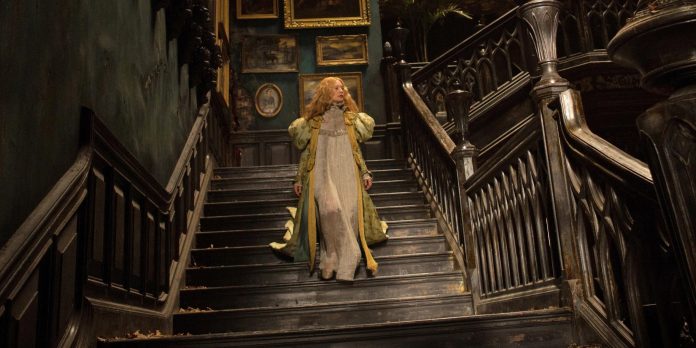THE STORY – A new bride investigates ghostly visions at a remote gothic mansion that holds dark secrets.
THE CAST – Mia Wasikowska, Jessica Chastain, Tom Hiddleston, Charlie Hunnam & Jim Beaver
THE TEAM – Guillermo del Toro (Director/Writer) & Matthew Robbins (Writer)
THE RUNNING TIME – 112 Minutes
If it wasn’t already more than evident that Guillermo del Toro’s heart has always been set on building a pathway towards an adaptation of Mary Shelly’s “Frankenstein,“ then “Crimson Peak“ is more than a firm reminder. In the decade since its release, this film has often slipped through the cracks of Del Toro’s filmography, partly due to its presentation to audiences in the months leading up to its release. “Crimson Peak,“ which was marketed as a horror film, has an overtly Gothic romantic nature that permeates the film’s DNA, just like the red clay that seeps into the snow of the titular estate. Del Toro’s never been one to shy away from wearing his heart on his sleeve, especially when it comes to the on-screen misfits and creatures he cherishes so dearly. While gastly entities are more than present, this may be one of the few times in this phase of his work where the “creatures“ themselves are the horrid depths that these characters are willingly plunging themselves into.
These phantoms are imminent from within the film’s opening moments as Mia Wasikowska’s Edith Cushing has been haunted by the ghost of her mother since she was a child, warning her to “Beware of Crimson Peak.“ Those words that remain indecipherable to her, even as an adult, still ring in her mind and her writing. Edith’s journey to becoming a writer confronted the challenges that many women in the early 20th century faced, not only from those in positions of power but also from those within her societal circle. Through her work endeavors, she encounters the English baronet Thomas Shapre, played by Tom Hiddleston, an inventor proposing a device to extract his family’s clay mine along with his sister Lucille, played by Jessica Chastain. Edith and Thomas’s burgeoning romance soon faces a new set of challengers as the couple moves from Buffalo, New York, to the Sharpes’s estate, Allerdale Hall, in Cumberland, England. Edith’s marriage is all but simple as she is confronted by the spirits of the estate, warning her of a life that’s much darker than she expected.
Like all of Del Toro’s productions, “Crimson Peak“ is a handsomely designed endeavor, as Allerdale Hall is too perfect an environment to torment Edith, who is as rigidly trapped as the ghouls that haunt it. The floors, faucets, and walls ooze the red clay that slowly sinks this manor like a building in Venice, plunging below into the water beneath it as the years pass. A metaphor may be too on the nose as it only accentuates the blood-fueled finale that transpires in the film’s final moments. Still, Thomas Sanders’s production design is stunning, only aiding Del Toro in creating an essence that tries its best to make up for the emptiness left by the characters who populate it. The same can be said about Dan Laustsen’s cinematography, whose work has become a staple of Del Toro’s live-action films. While all of Del Toro’s films look splendid, “Crimson Peak“ marks a notable shift in his visual style that has forever joined him and Laustsen at the hip. The costume design by Kate Hawley is also perfect, especially in conjunction with the overall design of Lucille’s look, which unravels in tandem with her character’s sanity as the film progresses.
While Del Toro does successfully capture the atmospheric allure of Gothic fiction, these flourishes, aided by his commitment to practicality as a filmmaker, are so ingrained in his films that they are not enough to compensate for the film’s bareness, as if it were the empty corridors of Allerdione Hall. Chastain, Wasikowska, and Hiddleston do their best, but the writing of “Crimson Peak“ comes off far more slight than Del Toro’s previous work. It lives in the shadow of similar films, but with a far more unrelieved energy. Del Toro and Robbins eventually find a groove, but by the time that occurs, it’s far too late. Not even the creative design of these clay-coated spirits could give leeway to how underwhelming an outing this is for Del Toro. Now, in a post-Del Toro “Frankenstein“ landscape, it’s somewhat fun to see the seeds planted all those years ago. From the recreation of certain shots, like Edith’s mother’s funeral, to the literal referencing of Mary Shelley as someone Edith aspires to be compared to. We can’t have one film without the other, both the good and the bad.


